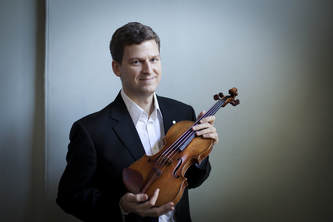 Canadian violinist James Ehnes.
Canadian violinist James Ehnes. Most classical music fans in Canada are well aware that Ehnes is also Canadian, hailing from the town of Brandon, Manitoba. And I expect most have probably already heard him, and are well aware of his astonishing prowess on his 1715 Stradivarius fiddle. (Hence, the sold-out house.)
But first, let’s talk Ehnes, in the opening two concertos: the A Minor BWV 1041, and the D Minor BWV 1052R. And although I’m not generally inclined to indulge in fanciful metaphors, I’ll use one now.
Ehnes’ playing – generally, and especially in the Bach we heard on Wednesday – reminds me of the Cathedral of Saint Pierre, in Geneva, Switzerland. Do you know it? It’s a Romanesque-Gothic church, built between 1160 and 1252. But in 1535, when the Protestant Reformation was sweeping through parts of Europe, Calvinists in Geneva claimed the church as their own and proceeded to strip it of its decorations. And it’s in this unadorned state that the church now stands: bare stone walls, with no statues, paintings, or anything else that might draw the eye’s attention away from the architecture of the building itself.
And that’s how Ehnes played Bach – emphasizing and bringing to life the glorious architecture embedded in the notes on the page. Clarity of tone, phrasing and tempo were the strong suits of his playing. Intonation? Flawless. Vibrato? Just a touch. Expressiveness? Yes, but only as a means to enhance the music’s structure. Baroque style? Not through fancy embellishments, as the early music players like to do – yet every movement had a strong, governing Affekt.
In the Concerto for Two Violins in D Minor BWV 1043 Ehnes partnered with violinist (and TSM Artistic Director) Jonathan Crow. And in the Concerto for Three Violins in D Major BWV 1064R, violinist Andrew Wan joined the other two soloists.
Playing with Ehnes, Crow and Wan were well balanced, adopting a similar emphasis on architectural clarity. But these two violinists also possessed qualities that Ehnes does not. Crow’s playing had a slightly laboured quality, and Wan displayed a brittle edginess in his tone. They are both excellent musicians – but stepping out next to Ehnes invited comparison to him, and they are not “A-list” concert soloists, as he is. (They are orchestral concert-masters: Crow with Toronto Symphony and Wan with the Montreal Symphony.)
As for the orchestra, their commitment to Ehnes’ leadership was apparent from the first note they played – and, as a student group with just a few days’ rehearsal together, they did a remarkably good job of accompanying the soloists. It speaks well of Toronto Summer Music that the festival is able to bring these students to Toronto and give them such an inspiring musical opportunity.
© Colin Eatock 2017
 RSS Feed
RSS Feed

